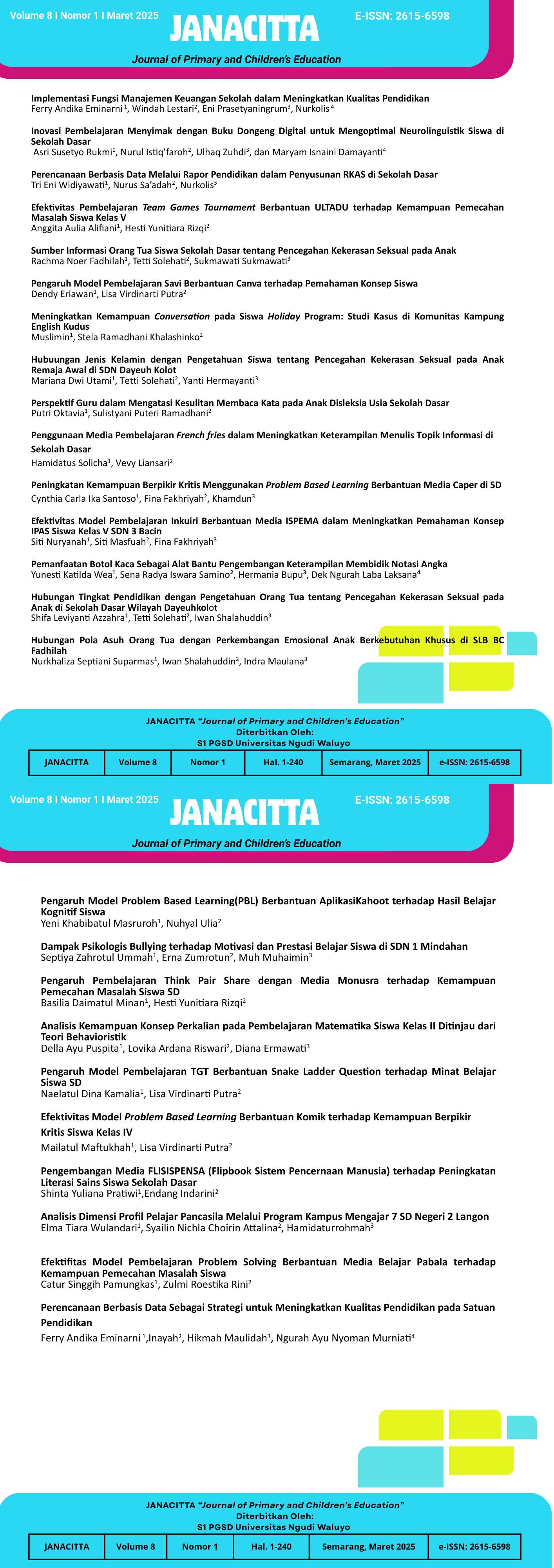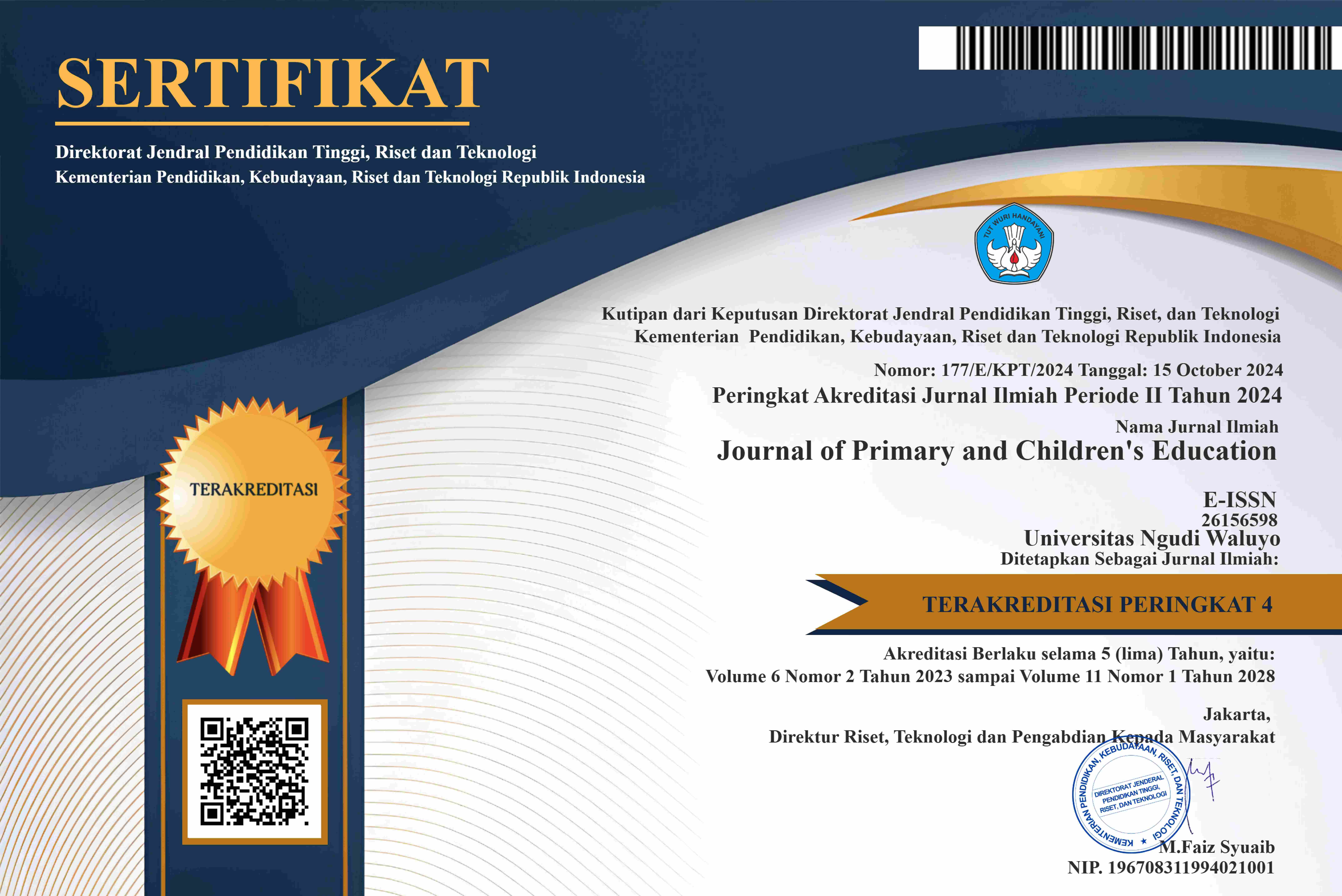Inovasi Pembelajaran Menyimak dengan Buku Dongeng Digital untuk Mengoptimal Neurolinguistik Siswa di Sekolah Dasar
DOI:
https://doi.org/10.35473/janacitta.v8i1.3833Keywords:
Listening, Storybooks, Digital, Neurolinguistics, Listening, Storybooks, Digital, NeurolinguisticsAbstract
Abstract
This study aims to examine the effect of using digital storybooks in improving listening skills among elementary school students, with a focus on optimizing neurolinguistics within the context of the Merdeka Curriculum. The research employs a quantitative method with a quasi-experimental approach involving two groups. These groups consist of an experimental group using digital storybooks as a medium for listening practice, and a control group using conventional learning methods. Data were collected through listening skill tests, classroom observations, student perception questionnaires, and semi-structured interviews. The results show that the experimental group experienced a significant improvement in listening skills, with higher post-test scores compared to the control group. The digital storybooks, which combine visual, audio, and interactivity elements, successfully enhanced student engagement and comprehension of the material being listened to. Overall, this study supports the use of digital storybooks as an effective learning medium to improve elementary students' listening skills and reinforces the principles of the Merdeka Curriculum, which is based on fun and creative learning.
Abstrak
Penelitian ini menganalisis inovasi pembelajaran menyimak dengan buku dongeng digital dalam mengoptimalkan neurolinguistik siswa sekolah dasar dalam konteks Kurikulum Merdeka. Dengan menggunakan metode kuantitatif dan desain eksperimen semu, penelitian ini membandingkan kelompok eksperimen yang menggunakan buku dongeng digital dan kelompok kontrol yang menerapkan metode konvensional. Hasil penelitian menunjukkan bahwa kelompok eksperimen mengalami peningkatan signifikan dalam keterampilan menyimak, dengan skor post-test meningkat dari 68 menjadi 84 (t = 12.89, p = 0.0001), dibandingkan dengan kelompok kontrol yang hanya naik dari 69 menjadi 74 (t = 2.51, p = 0.021). Secara neurolinguistik, buku dongeng digital yang menggabungkan elemen visual, audio, dan interaktivitas mampu merangsang berbagai area otak yang berperan dalam pemrosesan bahasa, seperti korteks auditori, korteks visual, dan area Broca serta Wernicke, sehingga meningkatkan pemahaman dan keterlibatan siswa dalam proses menyimak. Temuan ini menegaskan bahwa buku dongeng digital tidak hanya efektif dalam meningkatkan keterampilan menyimak tetapi juga berperan dalam mengoptimalkan pemrosesan bahasa siswa secara neurolinguistik. Oleh karena itu, buku dongeng digital dapat dijadikan media pembelajaran inovatif yang mendukung prinsip pembelajaran berbasis pengalaman dalam Kurikulum Merdeka.
References
Atikah, C., Asmawati, L., & Ekawati, R. (2023). Buku Digital Berbasis Fonetik Melalui Aplikasi Book Creator untuk Anak Usia Dini. Jurnal Obsesi : Jurnal Pendidikan Anak Usia Dini, 7(4), 4913–4924. https://doi.org/10.31004/obsesi.v7i4.4951
Azizah, N., & Hendriyani, W. (2024). Implementasi Penggunaan Teknologi Digital sebagai Media Pembelajaran pada Pendidikan Inklusi di Indonesia. Education, 10(2), 644–651.
Bourdeaud’hui, H., Aesaert, K., Van Keer, H., & van Braak, J. (2018). Identifying Student and Classroom Characteristics Related to Primary School Students’ Listening Skills: a Systematic Review. Educational Research Review, 25, 86–99. https://doi.org/10.1016/j.edurev.2018.09.005
Chai, M. T., Malik, A. S., Saad, M. N. M., & Rahman, M. A. (2019). Application of Digital Technologies, Multimedia, and Brain-Based Strategies. In Outcome-Based Strategies for Adult Learning (pp. 148–179). IGI Global. https://doi.org/10.4018/978-1-5225-5712-8.ch009
Creswell, J. W., & Creswell, J. D. (2018). Research Design: Qualitative, Quantitative, and Mixed Methods Approaches. In Writing Center Talk Over Time (Fifth Edit). SAGE Publications. https://doi.org/10.4324/9780429469237-3
Fajrie, N., Aryani, V., & Kironoratri, L. (2024). Media Belajar Digital Berbasis Kearifan Lokal Sebagai Sumber Bacaan Dongeng Sastra Anak. Jurnal Elementaria Edukasia, 7(1), 2262–2275. https://doi.org/10.31949/jee.v7i1.8123
Guntur, M., Rahayu, E. P., Ilise, R. N., Setyawati, N. S., Santi, N., Sangia, R. A., Isroani, F., Isniwati, & Fono, Y. M. (2023). Pengembangan Bahasa pada Anak Usia Dini. Selat Media. https://doi.org/978-623-09-4357-7
Hasanah, E., Maryani, I., Suyatno, & Gestiardi, R. (2023). Model Pembelajaran Diferensiasi Berbasis Digital di Sekolah. K-Media.
Kardika, R. W., Rokhman, F., & Pristiwati, R. (2023). Penggunaan Media Digital terhadap Kemampuan Literasi Multimodal dalam Pembelajaran Bahasa Indonesia. JIIP - Jurnal Ilmiah Ilmu Pendidikan, 6(9), 6715–6721. https://doi.org/10.54371/jiip.v6i9.2307
Nugraha, J. A., Yudha, A. A. N. B. K., & Ariesta, G. B. B. B. (2024). Perancangan Animasi 2 Dimensi Dongeng “Kisah Seorang Pemburu.” Jurnal Selaras Rupa, 5(2), 41–48.
Nurhan, M. (2023). Penerapan Metode Bercerita untuk Meningkatkan Kemampuan Menyimak pada Siswa Sekolah Dasar. Jurnal Sultra Elementary School, 4(2), 348–358. https://doi.org/10.54297/jses.v4i2.167
Rahiem, M. D. H. (2021). Storytelling in Early Childhood Education: Time to Go Digital. International Journal of Child Care and Education Policy, 15(1), 4. https://doi.org/10.1186/s40723-021-00081-x
Rizvic, S., Boskovic, D., Okanovic, V., Sljivo, S., & Zukic, M. (2019). Interactive Digital Storytelling: Bringing Cultural Heritage in a Classroom. Journal of Computers in Education, 6(1), 143–166. https://doi.org/10.1007/s40692-018-0128-7
Roth, R. E. (2021). Cartographic Design as Visual Storytelling: Synthesis and Review of Map-Based Narratives, Genres, and Tropes. The Cartographic Journal, 58(1), 83–114. https://doi.org/10.1080/00087041.2019.1633103
Ruswan, A., Rosmana, P. S., Nafira, A., Khaerunnisa, H., Habibina, I. Z., Alqindy, K. K., Amanaturrizqi, K., & Syavaqilah, W. (2024). Pengaruh Penggunaan Media Pembelajaran Berbasis Teknologi dalam Meningkatkan Kemampuan Literasi Digital Siswa Sekolah Dasar. Program Studi Pendidikan Guru Sekolah Dasar, Universitas Pendidikan Indonesia, 8(1), 4007–4016. https://doi.org/10.31004/jptam.v8i1.13009
Setiawan, Z., Pustikayasa, I. M., Jayanegara, I. N., Setiawan, I. N. A. F., Putra, I. N. A. S., Yasa, I. W. A. P., & Gunawan, I. G. D. (2023). Pendidikan Multimedia: Konsep dan Aplikasi pada Era Revolusi Industri 4.0 Menuju Society 5.0. PT. Sonpedia Publishing Indonesia.
Sumarni, Ambarwati, A., & Badrih, M. (2024). Pemanfaatan Spotify Sebagai Media Dongeng dalam Upaya Digitalisasi Sastra Anak. Didaktika: Jurnal Kependidikan, 13(1), 251–260. https://jurnaldidaktika.org
Taylor, M., Marrone, M., Tayar, M., & Mueller, B. (2018). Digital Storytelling and Visual Metaphor in Lectures: a Study of Student Engagement. Accounting Education, 27(6), 552–569. https://doi.org/10.1080/09639284.2017.1361848
Thaosiri, S., & Chano, J. (2022). The Development of an Instructional Model Based on Social Cognitive Theory to Enhance English Listening and Speaking Skills for Grade 6 Students in Small Size Schools. Journal of Educational Issues, 8(2), 20. https://doi.org/10.5296/jei.v8i2.19919
Tiwari, R. (2020). Listening Makes Communication Effective and Complete. Juni Khyat (UGC Care Group I Listed Journal), 10(6), 561–566. www.junikhyat.com
Urba, M., Ramadhani, A., Afriani, A. P., & Suryanda, A. (2024). Generasi Z: Apa Gaya Belajar yang Ideal di Era Serba Digital? DIAJAR: Jurnal Pendidikan dan Pembelajaran, 3(1), 50–56. https://doi.org/10.54259/diajar.v3i1.2265
Wardhani, P. A., Yarmi, G., & Yudha, C. B. (2024). Dongeng Digital Berbasis Project Based Learning untuk Penguatan Profil Pembelajaran Pancasila Siswa Sekolah Dasar. Jurnal PGSD: Jurnal Ilmiah Pendidikan Guru Sekolah Dasar, 17(1), 22–28. https://doi.org/10.33369/pgsd.17.1.22-28
Wulandari, N. K. D. (2024). Analisis Pelaksanaan Kegiatan Literasi dengan Program Gerli (Gerakan Literasi) yang Dikaitkan dengan Dongeng untuk Meningkatkan Minat Baca Siswa di SDN 1 Demulih. Morfologi: Jurnal Ilmu Pendidikan, Bahasa, Sastra dan Budaya, 2(6), 186–198. https://doi.org/10.61132/morfologi.v2i6.1170
Downloads
Published
How to Cite
Issue
Section
License
Copyright notice:
- Authors retain copyright and grant the journal right of first publication with the work simultaneously licensed under Creative Commons Attribution License that allows others to share the work with an acknowledgement of the work's authorship and initial publication in this journal.
- Authors are able to enter into separate, additional contractual arrangements for the non-exclusive distribution of the journal's published version of the work (e.g., post it to an institutional repository or publish it in a book), with an acknowledgement of its initial publication in this journal.
- Authors are permitted and encouraged to post their work online (e.g., in institutional repositories or on their website) prior to and during the submission process, as it can lead to productive exchanges, as well as earlier and greater citation of published work (The Effect of Open Access)







